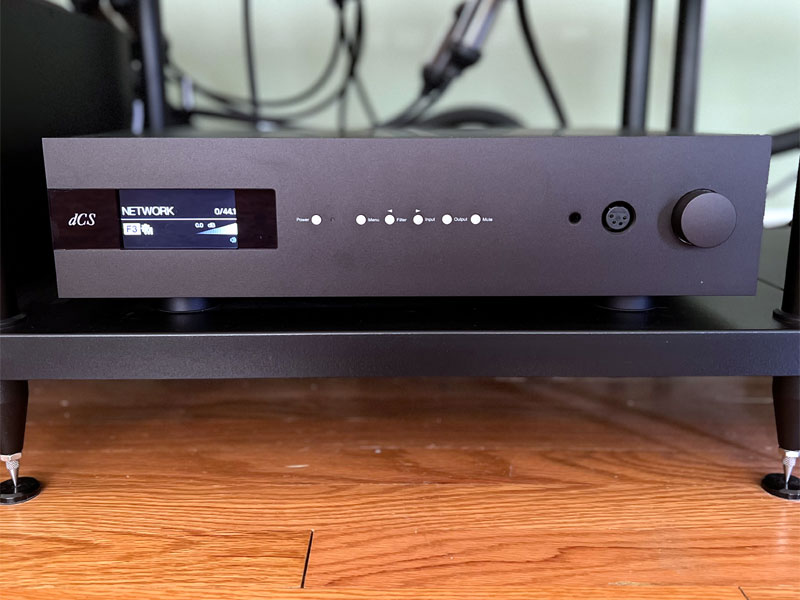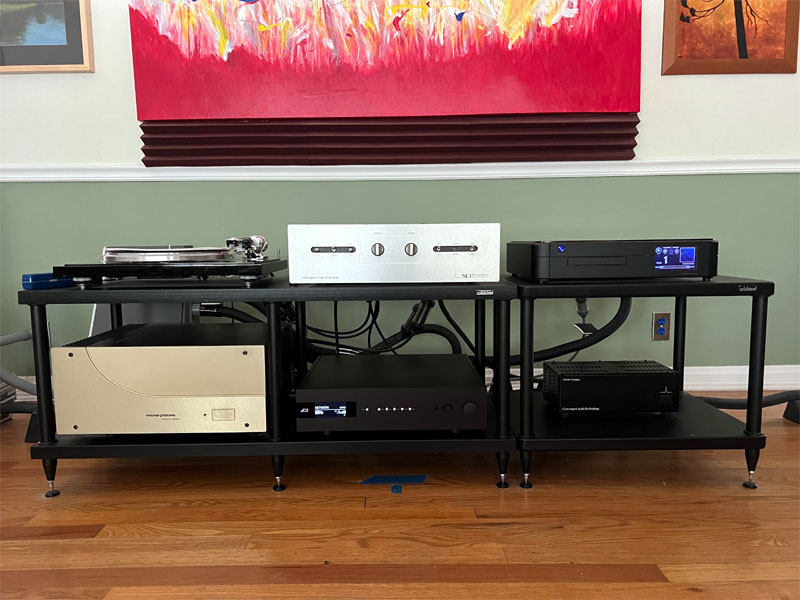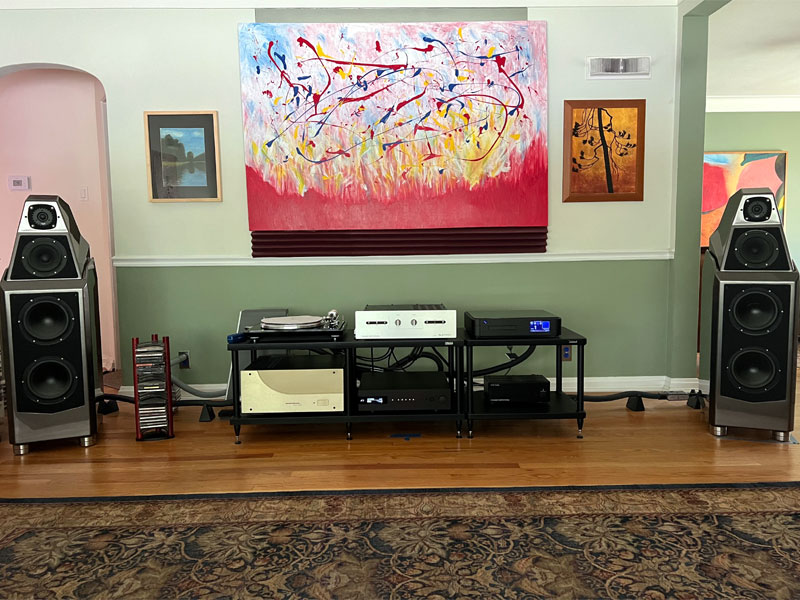First Sounds: dCS Bartók 2.0
t’s no exaggeration to say we are enjoying a golden age of digital audio. The high level of sound quality the average music lover can access from budget DACs now is astounding when compared to what was available just a few years ago. Some of that sonic progress is due to the cost-no-object research and development work conducted by cutting-edge companies like dCS. From creating the world’s first 24-bit analog-to-digital converter in the late 1980s to its pioneering work with jitter-reducing digital clocking devices, dCS is among a handful of companies that have been continually raising the bar in digital audio reproduction. The most recent example of dCS innovation is the unveiling of Bartók 2.0 ($17,950 without headphone amp, $19,950 with), a major overhaul of the company’s entry-level DAC/streamer/headphone amplifier’s firmware. Because this firmware upgrade was free to Bartók owners (like me) and can be downloaded in a matter of minutes, my sonic expectations were fairly low. I assumed I would hear subtle differences. However, the tectonic shift in sound quality was extraordinary. More on that later.
With Bartók 2.0, dCS is offering access to state-of-the art technology developed for its much pricier Rossini DAC. New features enable listeners to further customize playback according to their unique set of psychoacoustic listening preferences. While that might sound like marketing mumbo-jumbo, months of listening sessions with a diverse group of family and friends demonstrated to me that Bartók 2.0 represents a major leap forward in digital playback at this price point. My wife, an astute listener and discriminating music fan, was pleased enough with Bartók 1.0 to give me the green light last year to buy the review unit I was using. With the advent of the 2.0 firmware, we’ve both found ourselves using the word love when talking about the Bartók. We love how live and present our digital music now sounds. We love how easy it is to tailor the sound for streaming and playing compact discs. Exactly what pushes a person from liking an electronic device to loving it is complicated. For us, a product becomes beloved when it meets and exceeds expectations. Bartók 2.0 does that. Unlike some gear we’ve auditioned, it functions without glitches while rendering all of the eclectic array of musical styles and platforms we enjoy with such realism and authenticity that we find ourselves focusing on the music rather than the technology. When friends gather, Bartók 2.0 inspires more requests and longer listening sessions than any digital playback device we’ve had in the system. With Bartók 2.0, two additional boundary-pushing algorithms, called mappers, have been added to the device’s computing arsenal. According to my ears and those of friends who have heard Bartók 2.0, the payoff for this upgrade is improved soundstaging, added weight to instruments and voices, a significant increase in low-frequency detail, and a lower noise floor. Bartók 2.0’s new and improved mappers (called Mapper 1 and Mapper 3) are optimized for the new architecture and allow for a lower noise floor to be achieved by running at twice the speed of the original mapper (now Mapper 2), while still preserving the linear sound that owners like me have come to associate with dCS's Ring DAC. In practice, these mappers push the noise created by the Ring DAC outside the audible band of frequencies so that it can be filtered out before it reaches the listener. Bartók 2.0 also includes some additional psychoacoustics-driven filter settings that offer varying trade-offs between Nyquist image rejection, pre-ringing, post-ringing and phase response, as well as the option to upsample all incoming data to DSD128. Astute readers may have noticed that Bartók 2.0 now has exactly the same firmware used in dCS’s $28,000 Rossini 2.0 DAC. Prospective buyers will undoubtedly be curious about just how much of the Rossini’s vaunted performance can be found in Bartók 2.0. During a recent interview with John Giolas of dCS, he paused when asked the question and then said, “Well, if pressed, I would say 85-87 percent.” Not bad for a free firmware download. Rossini owners can leave Bartók owners in the rearview mirror with the option of upgrading to dCS’s newly unveiled Apex hardware. You'll read about this on The Audio Beat. Even though the Bartók 2.0 firmware upgrade is free, the platform required for it to push performance boundaries does not come cheap. But the shock of the admission price lessens a bit when you examine what’s packed inside the sleek casing. The Bartók resembles a ladder DAC, but there are key differences that make it unique. According to dCS’s published materials, the Bartok’s patented Ring DAC uses a “thermometer coded” DAC architecture, which involves manipulating 48 equal current sources within the Ring DAC. The Field Programmable Gate Array (FPGA) approach used by dCS engineers allows these current sources to be turned on and off in such a way that any component value errors are averaged out over time. But what does all that technology mean for listeners? Officials with dCS contend that the Ring DAC “almost entirely removes the linear distortion from the signal.” Those who study DAC design will tell you that linear distortion is one of the major reasons digital audio can sound artificial to many listeners. This may be one reason my wife and I perceive Bartók 2.0’s rendering of musical performances as more authentic and why we are so taken with its sound. While the computing power necessary for Bartók 2.0’s level of current-source management is impressive, I was proverbially gobsmacked by what I learned during further conversations with dCS about the level of sophistication involved in their Ring DAC and the latest firmware. According to Giolas, the Bartók contains algorithms that adapt to compensate for the degradation of individual parts and components within the unit. He added that these algorithms are even programmed to react in real time to temperature changes in order to make sure the highly sensitive quartz crystals within the Bartok’s clocks are always operating at optimal frequencies for the very best sonic performance. If someone were selling you a car that compensated for tire wear, road conditions and environmental factors, you’d certainly expect to pay a bit more for it. In a nutshell, Bartok’s adaptive algorithms represent a level of technological innovation you simply won’t find in moderately priced DACs. In order to test the new firmware’s improved computing prowess and the psychoacoustic theories that have driven its design, I decided to put Bartók 2.0 through its paces with a panel of seven very different music lovers. Four were audiophiles and three were not. During listening sessions, I provided no explanations of what changes were being made. All listeners selected their own music, and then I would provide "version 1" and "version 2" playback. The difference between each version was the application of one or the other of Bartók 2.0’s filters, upsampling modes and mapper algorithms.
Every listener was easily able to hear the differences between the mappers. After listening to several tracks, each had very distinct preferences. With respect to filters, six of the seven expressed varying degrees of preference, while one participant heard no differences between the filter settings. It's worth noting that these listening sessions did not entail endless a/b/a comparisons. Their preferences were formed fairly quickly and they did not require frequent re-comparisons. Satisfied that at least some of the acoustic results my wife and I were hearing from Bartók 2.0 were not merely the result of our family echo chamber, I decided to dive deeply into our various digital streaming platforms and extensive CD collection. On electronic releases like the New Zealand-based band Men I Trust’s Untourable Album (Tidal and Qobuz 16-bit/44.1kHz stream), the low-level information retrieval went beyond anything I’ve heard in my living/listening room. Bass tones were luxuriously textured and it was far easier to differentiate between those that were synthesizer generated and those that came from an electric bass. Timing was also considerably more in sync. After a recent upgrade to Shunyata’s heavy-gauge, lightning-fast Sigma NRV2 and Omega power cords throughout my system, I thought I’d pushed the dynamic bass-response envelope in my room about as far as it could go with my Wilson Sasha 2 speakers. It turns out that the Sashas and my listening space were capable of a lot more definition and authority than I’d thought possible and that there was far more low-level information from a streaming file than I’d come to expect. While Bartók 2.0 doesn’t fix challenged recordings, it does an exceptional job of extracting the essence of the performance from them. For example, Amy Winehouse’s Back to Black (Qobuz 24-bit/96kHz stream) has always sounded a bit bright and etched to my ears. With the Bartók 2.0 set for DSD upsampling, using Mapper 3, PCM Filter 3 and DSD Filter 5, Winehouse’s voice was imbued with more weight and the soundstage was more expansive. The leading edges of drums and guitars sounded more natural without robbing them of their characteristic snap and attack. Somehow this new firmware enabled me to focus on how Winehouse’s delivery can swerve from achingly vulnerable to wickedly sarcastic within a single number. By providing more breathing room for the sessions’ utterly in-the-pocket backup band on cuts like “You Know I’m No Good,” Bartók 2.0 reminded me why this is one of the great pop recordings of the early 21st century. On Dave Alvin’s King of California CD [Hightone Records HCD 8054], I could hear more of the deep-throated tonality and chesty reverberation in Alvin’s rich baritone. The texture of the soaring Dobro lines throughout the album was clearer and much more present than in the countless previous sessions I’ve had with this disc. What surprised me most was that I never realized that the bass on my favorite track, “Fourth of July,” comes from an electric bass. I could now clearly hear the amplifier tone setting. I also never noticed how the organ accompaniment was played to sound almost like a Mexican accordion. Are any of these subtle details that important? They are for me because they provided a deeper insight into how those musicians were working in conjunction with the rest of the band to raise the roof on that song’s chorus. Important details like that definitely give the composition more swing and they add an extra pinch of wistfulness to the proceedings. Bartók 2.0 has given me what feels like a virtual seat at Alvin’s recording sessions.
Those who’ve followed my reviews for The Audio
Beat know that I fall firmly in the “music first” camp of audiophiles, and
I have to give my wife some of the credit for that. Computers annoy us, fiddling with
knobs and buttons overwhelms us, and we have zero interest in hearing the squeak of a
musician’s chair in the far end of a recording studio. So it’s a bit ironic that
a DAC that houses a prodigious computer, offers dozens of acoustic settings and reveals
mountains of recorded information could be so appealing to ordinary music lovers like us.
To those of you who already have a comfortable relationship with your digital playback
system, I’ll offer some advice: approach this DAC with caution. After hearing what
Bartók 2.0 can do, you may begin to feel less satisfied and find yourself falling for its
seductive charms. |



